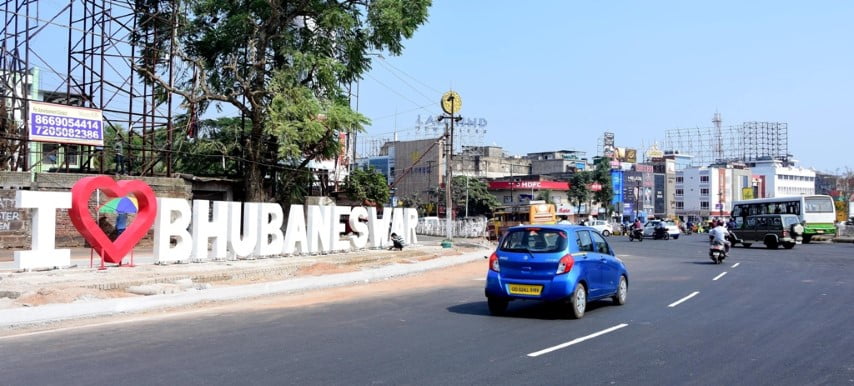Bhubaneswar: Caught In A Web Of Its Own Making!

Bhubaneswar, once the quiet capital of Odisha, has seemingly transformed itself into a bustling city today, competing with other metros for its pride of place. The development, however, has come at a cost. If the Bhubaneswar of the 1980s and 90s was all about green and abundant fresh air, it has morphed into a concrete jungle since then. The green canopy is lost and forgotten. Concrete structures have sprouted all around and unplanned growth has robbed the city of its aesthetic look. Worse still, the sense of ownership is missing.
But its not over yet. “Things are still under our control. We can still turn the city around, make Bhubaneswar what it should have been. Its the citizens who can make this happen,” said urban planner Piyush Rout, as the city turned 71 years old on Saturday.
- Population in 1951 was 16,500
- Estimated Population as of 2018: 12 Lakh
India’s first Prime Minister Jawaharlal Nehru had laid the foundation stone of Bhubaneswar on April 13, 1948, after it was planned by German architect Otto Königsberger.
The idea was to make it an administrative capital, which would essentially take care of its women, children and those who have remained associated with the city. It would be replete with parks and playgrounds and tree-lining avenues as the units develop. The objective was to carry ahead with this basic principle when the city went for the second phase of expansion with the development of Bapuji Nagar, Ashok Nagar, Gautam Nagar and Kharavel Nagar, Rout said. But somewhere down the line, the city began to take its own course, as dictated by its people.
If there is unplanned growth today, much of it is also because of the political class. It conveniently ignored the pitfalls of this type of growth for political interests, he argued.
World Heritage Tag:
Bhubaneswar has found mention since ancient times. It has been the nerve centre of Hinduism, Buddhism and Jainism and thus becomes a natural contender for the World Heritage Tag. But it has missed out to Ahmedabad and Chandigarh in this race.
Natural Water Bodies:
The city once boasted of as many as 10 water channels and a river system that traversed the length and breadth of the city. They have been reduced to canals and neighbourhood drainage systems. The river system is today better known as the Gangua canal.
Concrete Road:
There is no alternative to a concrete road, but the worrying part is that the sideways, pavements and footpaths are all being concretised, leaving no space for growth of trees and vegetation.
Gandhi Pillar:
Few may be aware, but the original town planners had envisioned a Gandhi pillar, a centre for performing arts in the city and a place which could inspire the younger generation to follow Gandhian principles in life. No one talks about it now.
Suggestions:
The need of the hour is creation of marshy land and massive expansion of green cover to free the city of the heat trap.
All efforts should be put in to get the world heritage status for Bhubaneswar. It will transform the city’s fortunes.
It should also be developed into a sports city. A beginning has been made and the momentum should be sustained.
ରାଜଧାନୀ ପ୍ରତିଷ୍ଠା ଦିବସରେ ସମସ୍ତଙ୍କୁ ମୋର ଆନ୍ତରିକ ଶୁଭେଚ୍ଛା। ସଂସ୍କୃତି ସମ୍ପନ୍ନ, ମନ୍ଦିର ମାଳିନୀ ଭୁବନେଶ୍ବର ଓଡ଼ିଶାର ଗରିମାକୁ ଯୁଗ ଯୁଗଧରି ଋଦ୍ଧିମନ୍ତ କରିଛି। ସମୃଦ୍ଧି ପଥରେ ସମସ୍ତଙ୍କୁ ଅଂଶୀଦାର କରି ଏହାର ଐତିହ୍ୟ ଓ ସଂସ୍କୃତିକୁ ବଜାୟ ରଖି ଅତ୍ୟାଧୁନିକ ଭିତ୍ତିଭୂମି ବିକାଶ ସ୍ମାର୍ଟସିଟି ଭୁବନେଶ୍ବରକୁ ସ୍ଵତନ୍ତ୍ର କରିଛି। pic.twitter.com/AhG5yPXzA7
— Naveen Patnaik (@Naveen_Odisha) April 13, 2019
Krishnendu Nandy, Architect:
“We need a vision for the city, a future roadmap for the city. What we see today is ‘crisis expansion’ — to address the immediate problems at our hand. Our objective should be to think 20 years down the line and plan accordingly,” said Nandy.
The Acharya Vihar-Nandankanan stretch is witnessing heavy traffic over the years. The need of the hour is to think of two to three parallel roads to decongest the stretch and the process should start right away.
Bhubaneswar tops the smart city list. But its scale is limited to a section of the city. Its principle should percolate to other areas as well. The city’s transport system has been revamped as part of this initiative. Bhubaneswar needs more of such measures.
Suggestions:
Strict enforcement of law can only deter unauthorised colonies and stop unplanned growth.
Bhubaneswar has a lot of natural drainage system. They need to be revived along with afforestation.
Green building should be the responsibility of all architectures.
Footpaths should be made friendly for the differently-abled. Use of footpaths for other means should be discouraged and penalised.

Comments are closed.